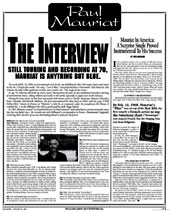MAURIAT IN AMERICA:
Billboard magazine - January 20th, 1996 - BY FRED BRONSON
A Surprise Single Proved Instrumental To His Success
If you wanted to achieve a No. 1 single in 1968, the conventional wisdom said that you didn't release an instrumental. Aftera ll, five years have gone by since an instrumental single had topped the Hot 100 - the last one to do so was "Telstar" by the Tornados in January 1963.
That may explain why no one was more surprised than Paul Mauriat when a track from his "Blooming Hits" album timidly debuted on the Billboard pop singles chart as No. 99 on Jan. 6, 1968. "Love is Blue" was one of many cover versions on the Philips album, although the song was new to Americans. Written by Andre Popp and Pierre Cour as "L'Amour Est Bleu," the song was performed by Vicky Leandros as Luxembourg's entry in the 1967 Eurovision Song Contest, held in Vienna. When the voting was completed, the song ranked fourth (Britain won the contest that year with Sandie Shaw's "Puppet On A String").
LEANDROS' LARGER DESTINY
Most Eurovision songs that come in fourth place are never heard from again, but "L'Amour Est Bleu" had a larger destiny. While Leandros recorded the song in 19 different languages, it wasn't a vocal version that would become an international hit.
By Feb. 10, 1968, Mauriat's "Love is Blue" was on top of the Hot 100, the first song by a French artist to top the American chart ("Dominique" was sung in French, but the Singing Nun was from Belgium). Two weeks later, there were four different versions of "Love Is Blue" on the chart. Mauriat was joined by Al Martino at No. 57, Claudine Longet at No. 97 and Manny Kellem at No. 100 (two years later, the Dells would incorporate the song into a medley, "I Can Sing A Rainbow/Love Is Blue". It peaked at No. 22).
PEG MARCHES AFTER PET
Ultimately, Mauriat had a five-week run at No. 1 with his blooming hit. It was not Mauriat's first experience of a No. 1 title, although no one realized it at that time. Five years earlier, he had been to the chart summit as songwriter. Under the pseudonym Del Roma, he was one of the composers of a French song, "Chariot." It became a European hit by Petula Clark, but the song gained international fame when it was translated into "I Will Follow Him" and recorded by Little Peggy March for RCA in 1963.
Eight years later, March was competing in a song festival in Majorca when a man she didn't know came up to her and thanked her for recording "I Will Follow Him." Puzzled, March why he was thanking her, and Mauriat revealed for the first time that he was one of the song's composers.
The success of "Love Is Blue" in the U.S. led to an American tour by Mauriat and various television appearances by the orchestra leader who had arranged, conducted and produced many recording sessions in his own country. And when 1968 was over, "Love Is Blue" stood as Billboard's No. 2 single of the year, second only to the Beatles's "Hey Jude".

